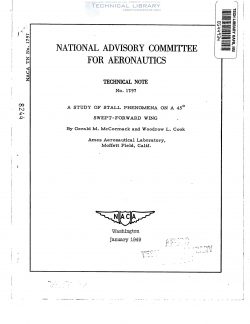naca-tn-1797
- Version
- 113 Downloads
- 1.22 MB File Size
- 1 File Count
- December 8, 2016 Create Date
- December 8, 2016 Last Updated
National Advisory Committee for Aeronautics, Technical Notes - A Study of Stall Phenomena on a 45° Swept Forward Wing

An investigation has been made to determine the underlying
causes of the undesirable longitudinal characteristics of a #50
swept—forward wing in the moderate and high lift—coefficient range.
Three—component force data, pressure—distribution data, tuft studies,
and boundaryadayer measurements were obtained to enable a detailed
correlation between separation phenomena and the longitudinal charac—
teristics of the swept—forward wing.
In the moderate lift range, the occurrence of turbulent sepa—
ration caused a chordwise redistribution of load over the inboard
sections. This, in turn, caused increases in drag and a rearward
shift of aerodynamic center but caused no loss of lift. In the high
lift range, the occurrence of leading-edge separation caused a loss
of section lift that occurred first over the inboard sections and
traveled outward as angle of attack was increased. This caused very
large increases in drag, a decreased lift—curve slope, and, due to‘
the changes in spanwise loading, caused an extremely large forward
shift of aerodynamic center.
In order to improve the longitudinal characteristics of the
swept—forward wing, both forms of separation must be postponed. The
evidence indicates that effort should be directed first toward post—
poning leading—edge separation. Only after leading—edge separation
is adequately postponed should control of the turbulent boundary
layer be attempted.
One of the most difficult problems connected with the design of
an airplane employing swept wings is the improvement of the poor
characteristics of swept wings in the moderate and high lift—
coefficient range. These poor characteristics are partially due to
the effects of sweep on the potential—flow field and partially due
to the occurrence of separation over the wing. The potential—flow
effects are sufficiently well understood and accurate methods of
prediction are available (reference 1) ; consequently, they will not
be discussed further herein. The effects of flow separation, on the
other hand, are only superficially known and the mechanism of flow
separation is quite obscure. Large increases of drag, sudden and
large fore and aft shifts of the aerodynamic center, decreases in
lift—curve slope, and eventually, of course, establishment of maximum
lift coefficient have all been rather generally known to be effects of
separation. These effects, furthermore, are manifested at relatively
low lift coefficients (sometimes in the lower half of the lift— -
coefficient range) and thus assume even greater importance than
correSponding effects on straight wings (wings with no sweep) where
separation is not emerienced to any appreciable extent until
maximum lift is reached.
| File | Action |
|---|---|
| naca-tn-1797 A Study of Stall Phenomena on a 45° Swept Forward Wing.pdf | Download |

Comment On This Post